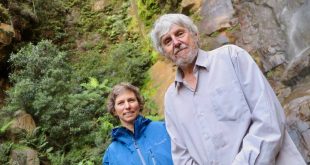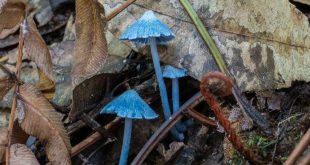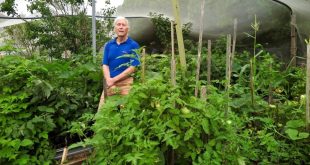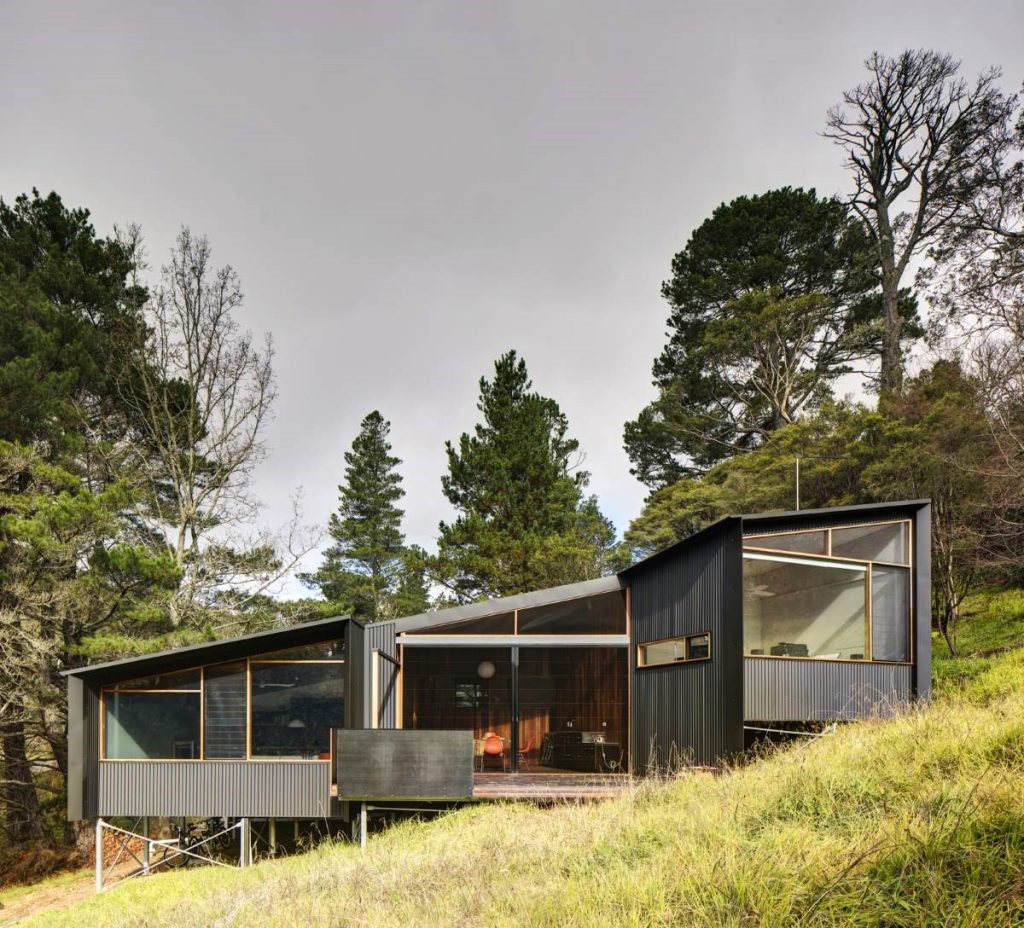
Carol and Ken’s home in Leura takes advantage of, and protects, the natural landscape. (Photo: Brett Boardman)
Story by Linda Moon
Ken and Carol’s home in Leura offers insights into sustainable building design we can all take inspiration from.
Key Points:
- Most Blue Mountains homes aren’t built for the local environment.
- Sustainable housing is more than solar panels and water tanks.
- By understanding and working with nature we can reduce energy costs and help the environment.
Perched on the hillside, a slate-coloured building blends into the landscape. There are no signs of a concrete drive, garage or fencing: those Aussie architectural mainstays. Instead, a mulched path meanders through conifer trees.
This isn’t your average property. Designed by architects Ken Yeh and Carol Marra (the multi-awarded Marra + Yeh), it has a lot to teach us about how to design alongside nature, for the planet and ourselves. It’s a journey so many of us are interested in.
Building with the environment in mind
The duo studied architecture at the University of Texas (where they met).
Ken:
Ken grew up around the tropical jungles of Malaysia and is both tutor and guest critic at the University of Sydney and UNSW. “I have a benchmark in my head of how things should be in a mature and stable eco-system. It’s a feeling. You go into a pristine place; all your senses can tell you. You can hear it; you can feel it.” His goal in designing is to try to discover what a place was originally like, then how to enhance it.
Carol:
Carol, who is originally from Argentina, also has a deep understanding of place. She also tutors and is a guest critic at the University of Sydney and UNSW. Carol says sustainable, ecological design (which the pair specialise in) starts with considering everything outside your piece of land and thinking holistically. “Across the street from us is a creek. We understand what happens here affects the waterway and the animals that drink it. So, it’s big picture thinking,” she says.
It’s also about making buildings that can survive the changing climate conditions, plus respond to the energy crisis.
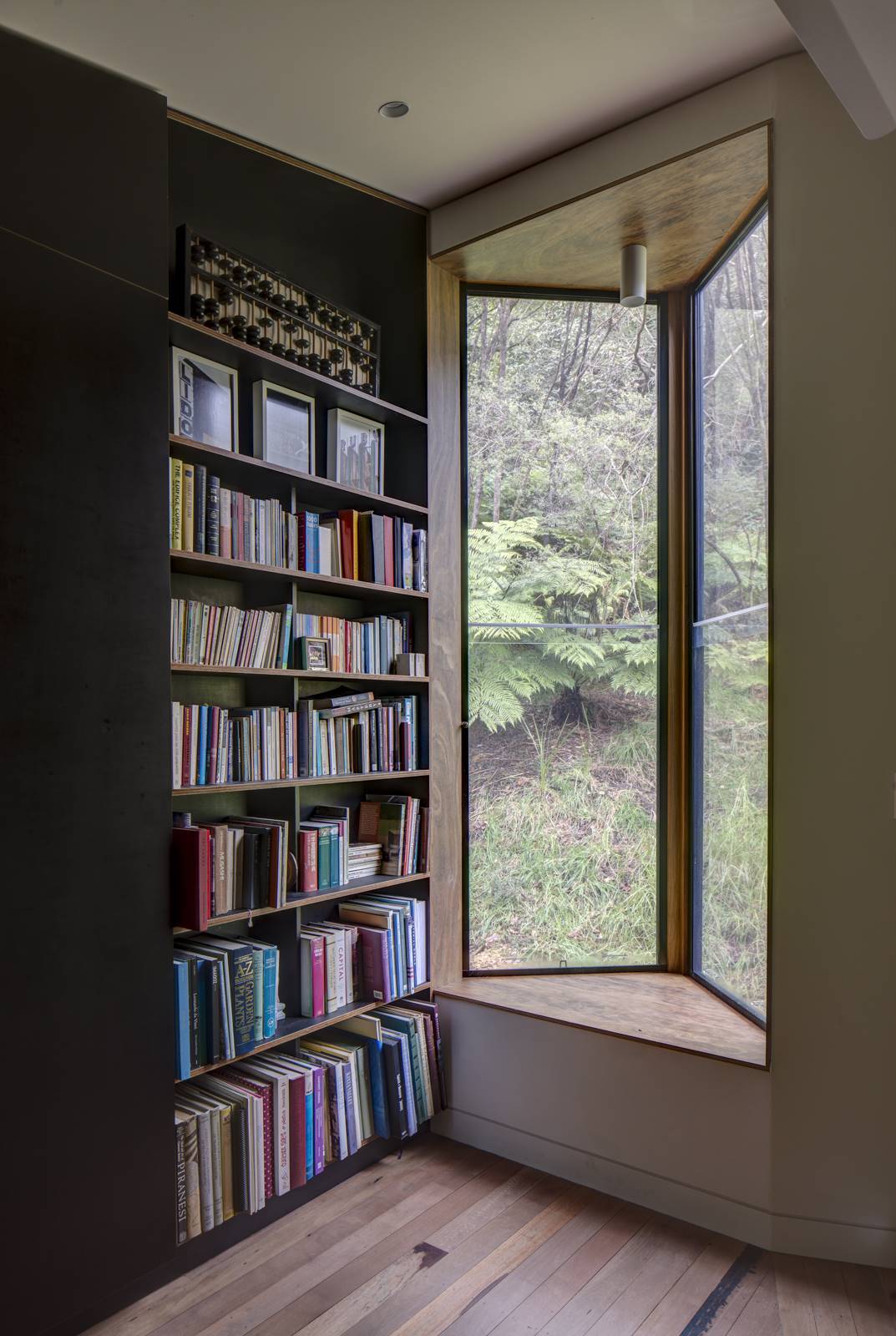
Two windows promote cross ventilation and natural sunlight while storage is a must. (Photo: Brett Boardman)
The house that Ken and Carol built
Elevated above a hanging swamp, the home’s design allows water to seep unimpeded down into the creek.
Caring for the land flows both ways. By not blocking the water’s path they avoid flooding and dampness, Carol says. Another perk: the relaxing sound of running water.
Inside, things are equally interesting. In the ‘mud-room’, as they call their entry, there’s a bench, washing machine, clothing rack and fridge. Here, dirty and wet clothing are discarded and shoes exchanged for slippers. It turns out the freezer is located here to reduce energy use: it’s the coldest zone of the house.

Sustainable architects Ken Yeh and Carol Marra at home. (Photo: Linda Moon)
Beyond solar panels and tanks
“Sustainable design is not just about adding on; it’s not just about buying solar panels,” Carol emphasises.
Our starting point should be to make use of everything nature gives us for free, Ken says. This includes sunshine (warmth), breezes (which cool), soil (for creating gardens) and water.
Every part of the building is planned consciously. Bedrooms are located on the south (least sunny side) of the building. “Sleeping in a cold room is better for you,” Carol says. And, being further from the road, it’s also quieter.
The bathroom is designed for multiple use with separate compartments for hand-basin, toilet and showering. The latter includes an adjustable-size wooden Japanese bathtub (designed by the pair) and an expansive window that looks out onto 3D art courtesy of nature: trees, occasional wallabies and birds.
Bathing with the window open allows airflow to remove humidity and condensation.
“You need to identify the gifts [of nature] and accept them humbly.” – Ken Yeh.
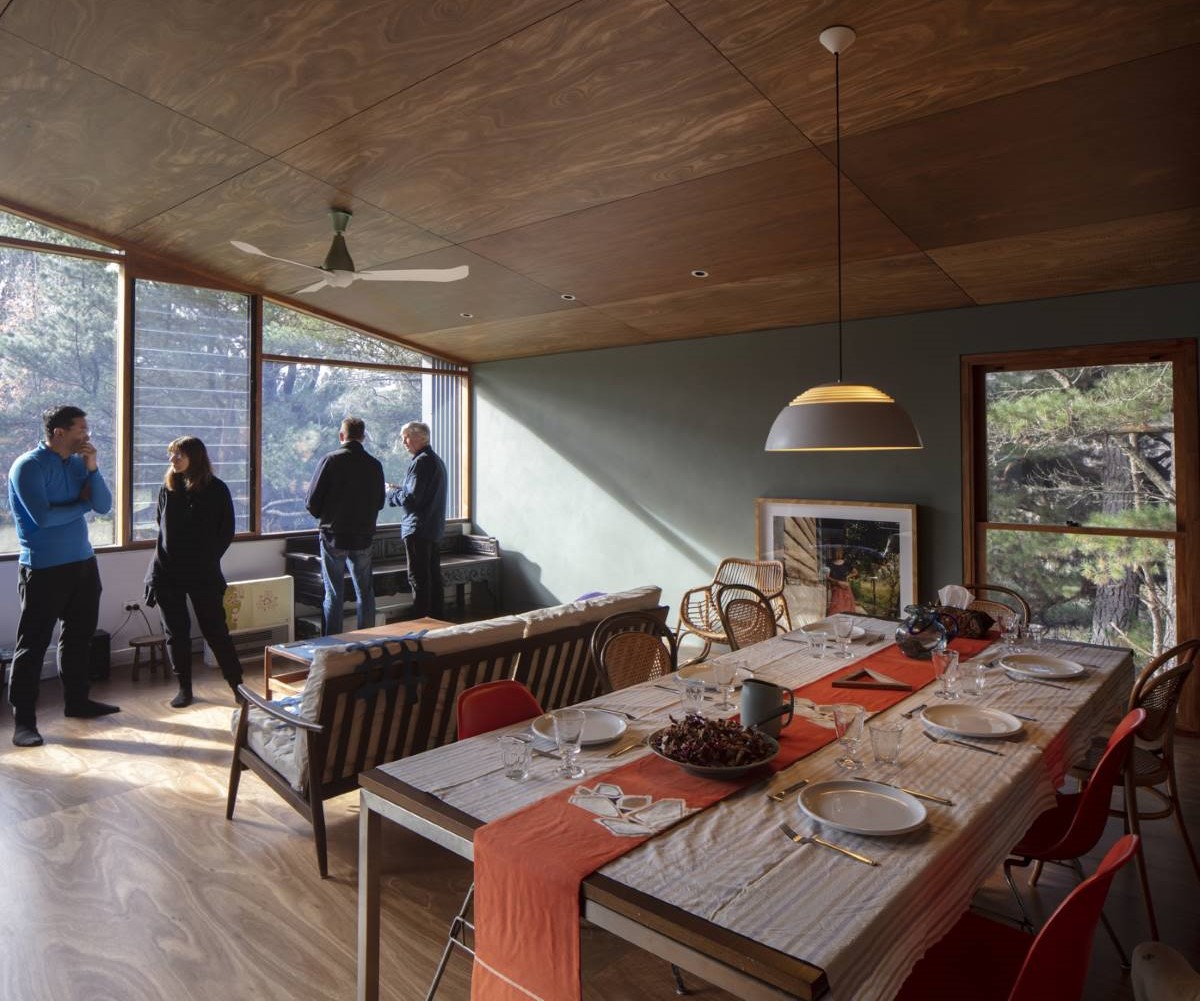
Large north-facing, double-glazed windows harness the sun’s heat and light. (Photo: Brett Boardman)
Passive design
Designing with your local climate in mind is known as ‘passive design’. Some understanding around science, like wind direction and the sun’s angle, helps here, Carol adds.
To capture free heat from the sun, the main living zones are situated in the north. Large, double-glazed, north facing windows allow sunlight to penetrate deep into the rooms. On sunny days these don’t require artificial heating, which equals lower energy costs and CO2 emissions.
When it’s hot they open the windows to the breeze or use blinds to block the sun. “It’s a way of calibrating your building to what’s happening outside,” Ken says.
The rooms are also designed to be compartmentalised to keep the heat in. “In winter you create smaller spaces; in summer bigger spaces,” Carol says. “You live in nature.”
The living area opens up to an outdoor space with a kitchen and insect-proof screens that allow them to take advantage of any cooling breezes on hot summer nights.
In the mountains most winds come from the west. Thus, the house has few windows facing west.
“Look at nature first. The water flows under, the wind flows over.” – Ken Yeh.
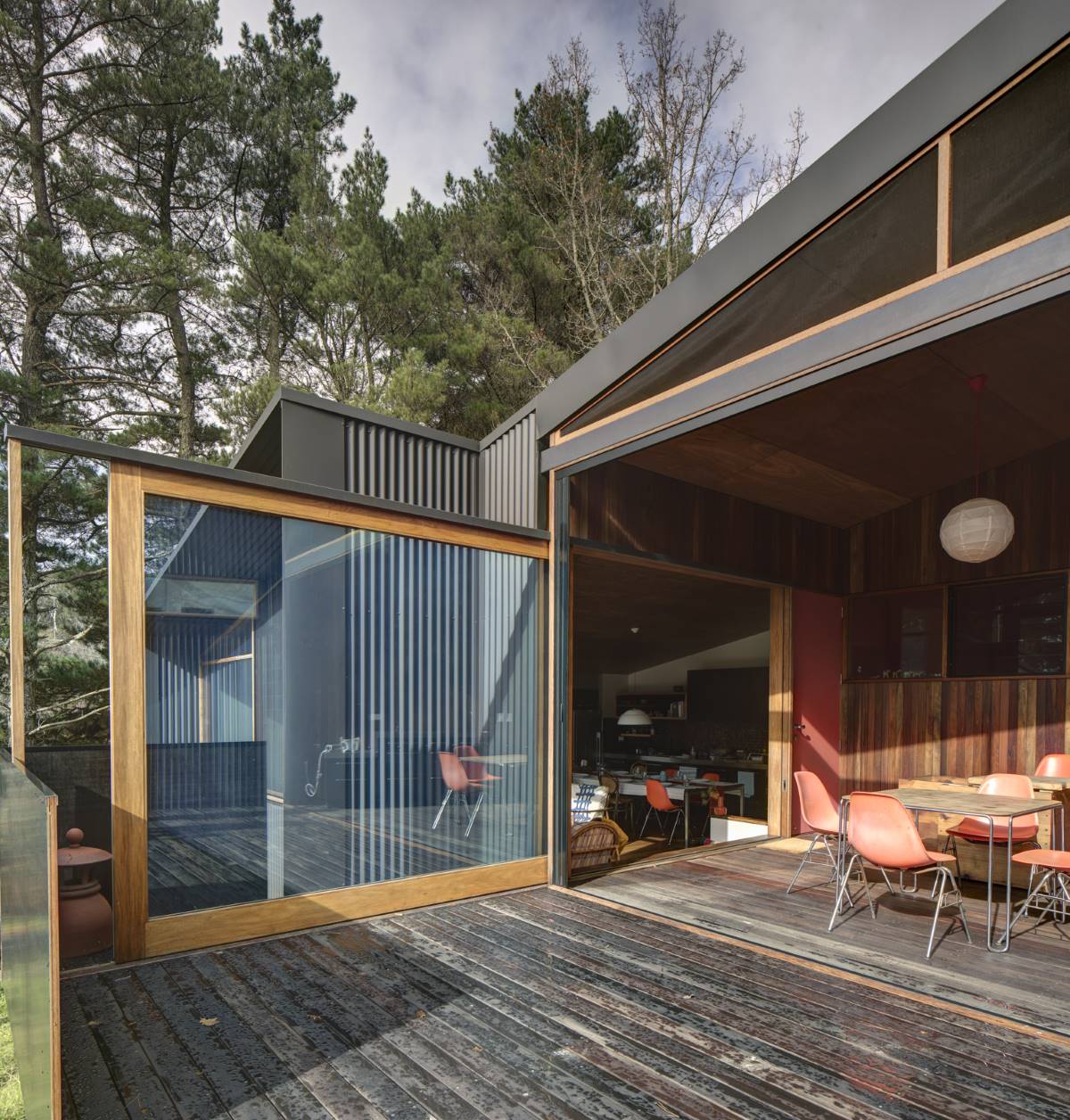
Space for a wok BBQ. The indoors and outdoors blend seamlessly thanks to clever use of glass and almost invisible insect screens. (Photo: Brett Boardman)
Designing for flexibility and change
Other important features of the home include built-in storage cupboards and enormous doors between several rooms. This allows for flexibility. Rooms can be opened up to become bigger or used for a different purpose.
It’s about designing alongside time, Ken says. How we work and study, for instance, has changed; the composition of families changes, Carol says. The ability to enable change without too much pain adds value to a building.
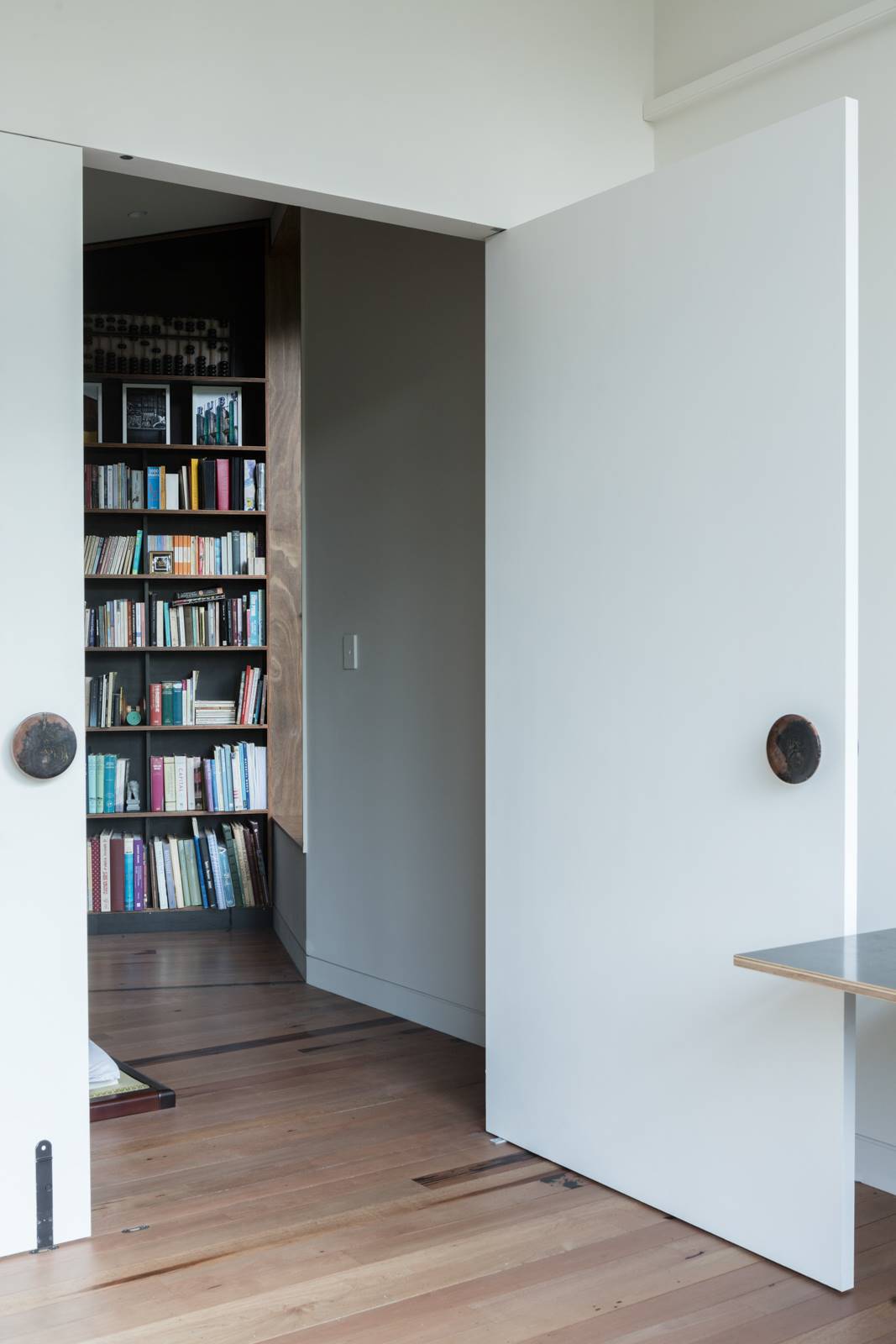
Large doors allow spaces to be merged, enlarged and compartmentalised. (Photo: Brett Boardman)
Challenges for mountains homes
Unfortunately, few buildings in the Blue Mountains (or beyond) are designed sustainably.
“It’s a very extreme climate and we don’t make people design for this in our policies,” Carol says. The result is that many of us suffer in cold homes inappropriate for the climate with the knock-on of high heating bills. It’s a housing legacy we continue to pass onto the next generation, Carol says.
Other big challenges facing our housing (and thus our wellbeing) are affordability and lack of suitability. “The marketplace tends to cater for two types of homes: low-density, single-family dwellings and high-density apartments,” Carol says.
Housing, like nature, needs to be biodiverse. This means having housing styles that cater to extended families, older people and others.
Retrofitting your home
Integrating where we live with nature is something we can all do, Carol says. “We have a lot of opportunities to change things and do things better.”
As a starting point, they recommend focusing on the skin of your building with insulation, sealing and draught proofing. Improve the performance of any poor-quality windows. If you can, create an enlarged, double-glazed window in the north of your home.
This way you won’t need as many solar panels. “It’s like putting a jacket on before you blast the heater,” Carol says.
“You can do something at any scale that’s positive and impactful” – Carol Marra.
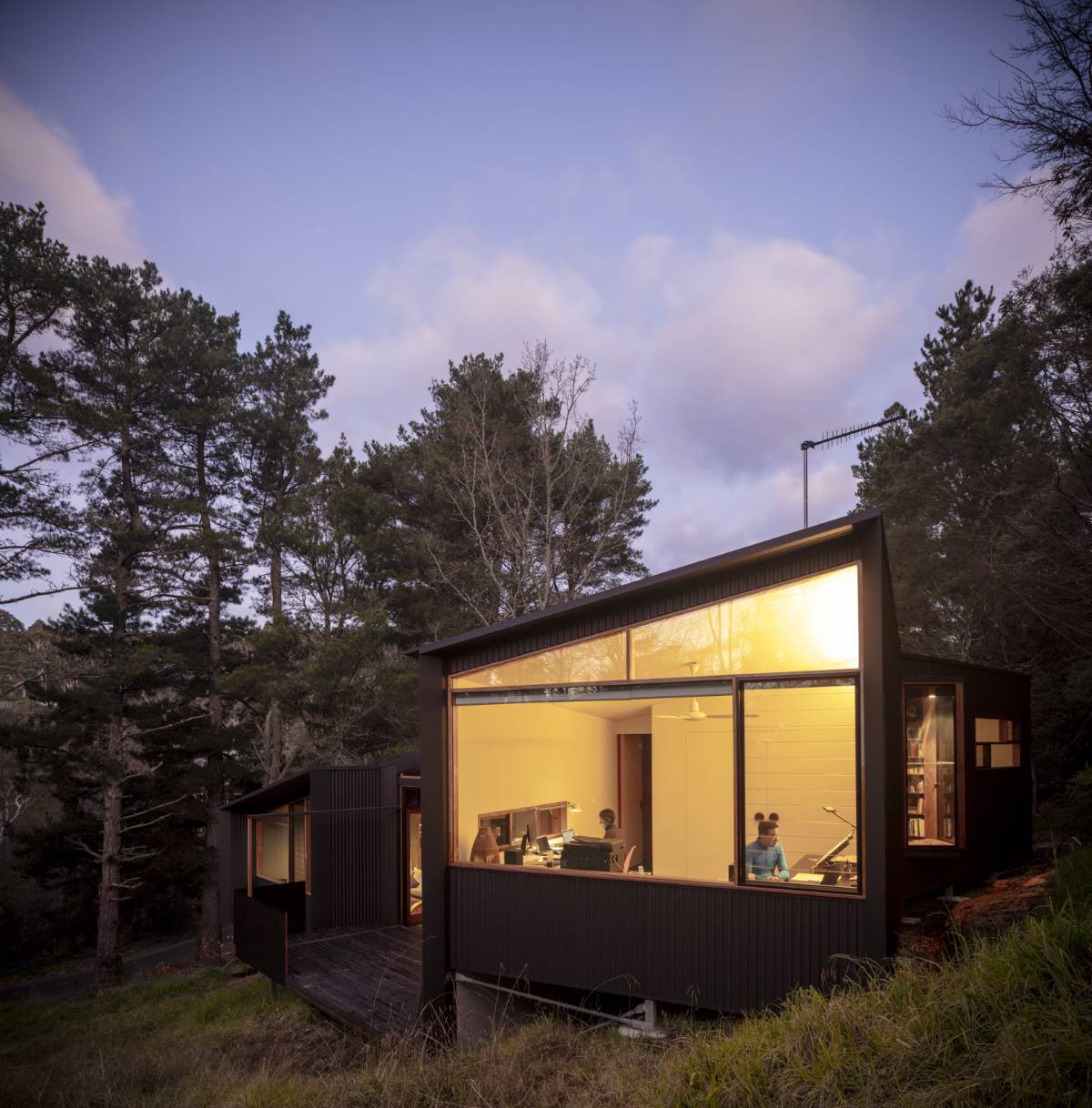
Harmonious exterior of the home office. Minimal impact upon and maximum gain from the environment. (Photo: Brett Boardman)
Take Action:
- Make your home more water and energy efficient.
- Protect and enhance the landscape around you.
- Integrate nature’s gifts into your home.
Share this article:
This story has been produced as part of a Bioregional Collaboration for Planetary Health and is supported by the Disaster Risk Reduction Fund (DRRF). The DRRF is jointly funded by the Australian and New South Wales governments.
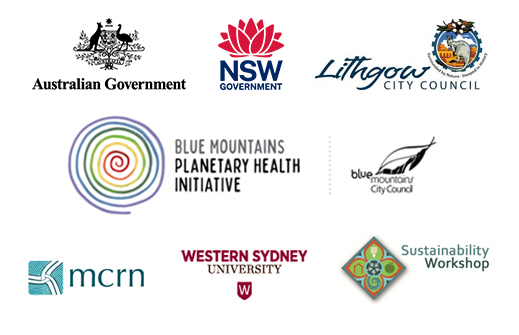
More from around the region
In April 2021 Blue Mountains City Council became the first Council and government entity in Australia to commit to integrating Rights of Nature (RON) principles into its operations and practices. Yesterday we were thrilled to be able to spend a few hours with Susie Talbot, an Australian lawyer, based in the UK, who was visiting on a Churchill Fellowship to explore the implementation of Rights of Nature in different parts of the world. It was inspiring to hear how she has spent decades using the law to achieve transformative change in relation to complex socio-economic and environmental challenges. In 2020, she founded the Anima Mundi Law Initiative to strengthen the intersections between human rights and ecology, and to encourage the practice of law in alignment with planetary realities and collective consciousness. Projects include the creation of a ‘Rights of Nature Toolkit’ and we look forward to working with her into the future. You can read more at her website: https://www.animamundilaw.org/
Photo: Susie Talbot standing in front of Scott Marr`s artwork in the Planetary Health Exhibition space.
#rightsofnature #earthjurisprudence #anewlegalstoryforanecologicalage #ecologicalage #churchillfellowship @churchillfellowship #animamundi #humanrights #ecology #planetaryhealth
Nelson Mandela once said “Education is the most powerful weapon which you can use to change the world”; and William Butler Yeats, the great poet, said “Education is not the filling of a pail but the lighting of a fire.” If you’re a teacher, educator or involved in education in some way in the Blue Mountains the staff of the Blue Mountains Planetary Health Initiative would love to meet you next Monday 20th May when we join the Blue Mountains Sustainable Schools Network to see how we can all join forces to urgently accelerate the change we need to restore the health of our planet. 3.30-5.30 at Faulconbridge Public School. RSVP Beth Healy DirtMum (details in poster)
#sustainableschoolsnetwork #collaboration #planetaryhealth #environmentaleducators #artteachers #englishteachers #musicteachers #allteachers
Hans and Tillie Coster have brought a Tolkien fantasy to life, building an underground Hobbit Hall at their property ‘Middle Earth’ in the Kanimbla Valley. They`ve come very close to self-sufficiency, storing their solar power in banks of nickel-iron batteries, and building underground has meant they`re more able to withstand extreme weather events. They`ve also reforested degraded country, planting over 3000 trees! Read more in Lithgow Area Local News (link in profile):
https://lithgowlocalnews.com/middle-earth-kanimbla-valley/
#middleearth #hobbiton #hobbithall #kanimblavalley #selfsufficient #offgrid #nickeliron #solarbatteries #nickelironbatteries #reforestation #undergroundhouse #compostingtoilet #disasterriskreduction #planetaryhealth
There are only about 750 Dwarf Mountain Pine plants left in the wild, according to the latest survey. The survivors are limited to waterfall spray and seepage zones in the southern escarpment between Katoomba and Wentworth Falls, but renewed efforts to save it in light of its potential upgrade to ‘critically endangered’ status are giving greater recognition to a rare and unusual prehistoric native in our midst. Read more in Katoomba Area Local News (link in profile)
https://www.katoombalocalnews.com/saving-the-dwarf-mountain-pine/
#dwarfmountainpine #criticallyendangeredspecies #prehistoricnative #biodiversity #collaboration #whatwecando #katoomba #wentworthfalls #bluemountains #planetaryhealth
Our Planetary Health newsletter is now out, sharing inspiring stories from the Lower Mountains to Lithgow: Read it here and subscribe via any of the Local News sites: https://bit.ly/3QKevs6 (link in profile)
Katoomba Area Local News: Living on the Ledge: Saving the Dwarf Mountain Pine
Lithgow Local News: How a Tolkien Fantasy Turned Into Off-grid Reality at Middle-Earth in the Kanimbla Valley
Blackheath Area Local News: Inspirational, Intergenerational Play in Blackheath
Lower Mountains Local News: The Positive Social Impact of the Glenbrook Country Women’s Association
Mid Mountains Local News: Stronger Together: Mid Mountains Neighbourhood Centre Walks the Talk
Springwood Area Local News: People Of Binfluence: The 2024 Binfluencer Awards
#solutionsmedia #hyperlocalnews #planetaryhealth #localstories #inspiration #bluemountains #lithgow
Woohoo we just hit 1 MILLION views on our reel about Physicist Hans Coster and why he`s using nickel-iron batteries.
You can now read the full story and watch a video about him and his wife Tillie at their property Middle Earth (links in profile). We`d love you to subscribe to our Blue Mountains Planetary Health YouTube channel and share the latest video on him there as well.
The video is fabulous:
https://www.youtube.com/watch?v=3kqAczIRzqk&t=17s
#offgrid #underground #nickelironbatteries #planetaryhealth #reforestation #selfsufficient #middleearth #bagshotrow
A small group of Blue Mountains women is helping local women survive and thrive and also contributing to improve maternal and newborn survival in developing countries. Assembling birthing kits for women in remote locations is just one of the many ways the @zontaclubbluemountains is empowering and supporting women, both abroad and at home. Read more in Lower Mountains Local News (link in profile)
https://lowermtnslocalnews.com/zonta-blue-mountains/
#womensupportingwomen #maternalhealth #birthingkits #zontainternational #zonta #abetterworldforwomen #localaction #localactionglobalimpact #planetaryhealth
We are thrilled to announce that award-winning health writer and author Sophie Cousins will be leading the workshop: Our Community, Our Stories: Writing for Change from 2-5pm on Saturday 25 May at the Planetary Health Precinct. Sophie`s work has been published in the New York Times, London Review of Books, the Guardian, the Lancet, Meanjin and others. She also works as a public health consultant for the World Health Organisation. The workshop will be followed at 7pm by the launch of the Planetary Health Writers Network. Places are limited so bookings essential (link in profile): https://www.eventbrite.com.au/e/our-community-our-stories-writing-for-change-tickets-895548458547
#writingforchange #impactfulstories #solutionsjournalism #writingworkshop #planetaryhealth #changethestory #thenewsweneed #writersnetwork #bluemountains #katoomba
We`re thrilled to welcome Tamsyn McGrouther to our growing team of volunteer storytellers. She`s reporting on how the Springwood Lot Party transformed an underused space, the car park at Springwood Train Station, into a vibrant community space with food stalls, art opportunities and live music. Read more in Springwood Area Local News (link in profile) : https://springwoodlocalnews.com/springwood-lot-party-2024/
#changethestory #hyperlocalmedia #solutionsmedia #springwood #inspiringstories #planetaryhealth #bluemountains #localnewsmatters
What do tea, samurai clans, William McArthur, Benjamin Franklin, Vietnam and the Botanic Gardens at Mount Tomah have in common? Read our story in Blackheath Area Local News to explore the way camellias and cultures are woven together and why it’s important we think about conserving biodiversity as a global project implemented at a local level. (link in profile) https://blackheathnews.com/camellias-at-blue-mountains-botanical-garden/
@botanicsydney #botanicgardens #mountomahbotanicgardens #camellias #camelliasinensis #tea #samurai #bluemountains #themounts #biodiversity #planetaryhealth
Mushrooms are a hot topic at the moment with more and more research illuminating the essential role these organisms play in the health of the planet as well as the significant health and medicinal benefits they hold for humans. Belle Butler visited local mushroom grower, Alex Felix, at his farm in Lawson to talk about the mighty mushroom. Read more in Mid Mountains Local News (link in profile)
https://www.midmtnslocalnews.com/earthrising-mushroom-farm/
#mushroomgrowkit #mushrooms #fungi #growyourown #lawson #bluemountains
Mushrooms are a hot topic at the moment with more and more research illuminating the essential role these organisms play in the health of the planet as well as the significant health and medicinal benefits they hold for humans. Belle Butler visited local mushroom grower, Alex Felix, at his farm in Lawson to talk about the mighty mushroom. Read more in Mid Mountains Local News (link in profile):
https://www.midmtnslocalnews.com/earthrising-mushroom-farm/
#lawson #mushroomfarming #fungi #mushroomcompost #oystermushrooms #mushroomgrowkit #bluemountains


